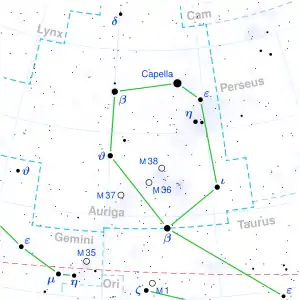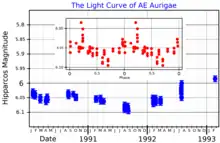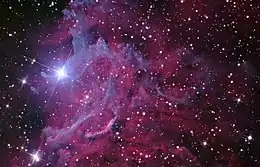AE Aurigae
AE Aurigae (abbreviated as AE Aur) is a runaway star in the constellation Auriga; it lights the Flaming Star Nebula.
 | |
| Observation data Epoch J2000 Equinox J2000 | |
|---|---|
| Constellation | Auriga |
| Right ascension | 05h 16m 18.15000s[1] |
| Declination | +34° 18′ 44.3455″[1] |
| Apparent magnitude (V) | 5.96[2] (5.78 - 6.08[3]) |
| Characteristics | |
| Spectral type | O9.5V[4] |
| U−B color index | −0.70[2] |
| B−V color index | +0.22[2] |
| Variable type | Orion variable[3] |
| Astrometry | |
| Radial velocity (Rv) | 56.70±0.6[5] km/s |
| Proper motion (μ) | RA: -4.440[6] mas/yr Dec.: 43.368[6] mas/yr |
| Parallax (π) | 2.4642 ± 0.0660 mas[6] |
| Distance | 1,320 ± 40 ly (410 ± 10 pc) |
| Details[7] | |
| Mass | 23 M☉ |
| Radius | 7.47 R☉ |
| Luminosity | 59,000 L☉ |
| Surface gravity (log g) | 4.0 cgs |
| Temperature | 33,000 K |
| Rotational velocity (v sin i) | 25[7] km/s |
| Other designations | |
| Database references | |
| SIMBAD | data |
Description

AE Aurigae is a blue O-type main sequence dwarf with a mean apparent magnitude of +6.0. It is classified as an Orion type variable star and its brightness varies irregularly between magnitudes +5.78 and +6.08. It is approximately 1,300 light-years from Earth.
AE Aur is a runaway star that might have been ejected during a collision of two binary star groups. This collision, which also is credited with ejecting Mu Columbae and possibly 53 Arietis, has been traced to the Trapezium cluster in the Orion Nebula two million years ago. The binary Iota Orionis may have been the other half of this collision.[9]

AE Aur is seen to light up the Flaming Star nebula, but it was not formed within it. Instead it is passing through the nebula at high speed and producing a violent bow shock and high energy electromagnetic radiation.[10][11]
Companions
Possibly due to its runaway star nature, AE Aurigae has no physical companion stars, although some nearby stars have been erroneously identified as ones. A theoretical companion 1000 AU (0.016 light-years) away from AE Aurigae would have an angular separation of less than 2.5 arcseconds and would probably be lost in the star's glare.
References
- Van Leeuwen, F. (2007). "Validation of the new Hipparcos reduction". Astronomy and Astrophysics. 474 (2): 653–664. arXiv:0708.1752. Bibcode:2007A&A...474..653V. doi:10.1051/0004-6361:20078357. S2CID 18759600.
- Ducati, J. R. (2002). "VizieR Online Data Catalog: Catalogue of Stellar Photometry in Johnson's 11-color system". CDS/ADC Collection of Electronic Catalogues. 2237. Bibcode:2002yCat.2237....0D.
- Samus, N. N.; Durlevich, O. V.; et al. (2009). "VizieR Online Data Catalog: General Catalogue of Variable Stars (Samus+ 2007-2013)". VizieR On-line Data Catalog: B/GCVS. Originally Published in: 2009yCat....102025S. 1. Bibcode:2009yCat....102025S.
- Sota, A.; Maíz Apellániz, J.; Walborn, N. R.; Alfaro, E. J.; Barbá, R. H.; Morrell, N. I.; Gamen, R. C.; Arias, J. I. (2011). "The Galactic O-Star Spectroscopic Survey. I. Classification System and Bright Northern Stars in the Blue-violet at R ~ 2500". The Astrophysical Journal Supplement. 193 (2): 24. arXiv:1101.4002. Bibcode:2011ApJS..193...24S. doi:10.1088/0067-0049/193/2/24. S2CID 119248206.
- Kharchenko, N. V.; Scholz, R.-D.; Piskunov, A. E.; Röser, S.; Schilbach, E. (2007). "Astrophysical supplements to the ASCC-2.5: Ia. Radial velocities of ˜55000 stars and mean radial velocities of 516 Galactic open clusters and associations". Astronomische Nachrichten. 328 (9): 889. arXiv:0705.0878. Bibcode:2007AN....328..889K. doi:10.1002/asna.200710776. S2CID 119323941.
- Brown, A. G. A.; et al. (Gaia collaboration) (August 2018). "Gaia Data Release 2: Summary of the contents and survey properties". Astronomy & Astrophysics. 616. A1. arXiv:1804.09365. Bibcode:2018A&A...616A...1G. doi:10.1051/0004-6361/201833051.
- Martins, F.; Hervé, A.; Bouret, J.-C.; Marcolino, W.; Wade, G. A.; Neiner, C.; Alecian, E.; Grunhut, J.; Petit, V. (2015). "The MiMeS survey of magnetism in massive stars: CNO surface abundances of Galactic O stars". Astronomy & Astrophysics. 575: A34. arXiv:1411.4420. Bibcode:2015A&A...575A..34M. doi:10.1051/0004-6361/201425173. S2CID 119258285.
- Marchenko, S. V.; Moffat, A. F. J.; van der Hucht, K. A.; Seggewiss, W.; Schrijver, H.; Stenholm, B.; Lundström, I.; Setia Gunawan, D. Y. A.; Sutantyo, W.; van den Heuvel, E. P. J.; De Cuyper, J. P.; Gómez, A. E. (March 1998). "Wolf-Rayet stars and O-star runaways with HIPPARCOS II. Photometry". Astronomy & Astrophysics. 331: 1022–1036. Bibcode:1998A&A...331.1022M. Retrieved 29 October 2021.
- Hoogerwerf, R.; De Bruijne, J. H. J.; De Zeeuw, P. T. (2001). "On the origin of the O and B-type stars with high velocities. II. Runaway stars and pulsars ejected from the nearby young stellar groups". Astronomy and Astrophysics. 365 (2): 49. arXiv:astro-ph/0010057. Bibcode:2001A&A...365...49H. doi:10.1051/0004-6361:20000014. S2CID 18970167.
- López-Santiago, J.; Miceli, M.; Del Valle, M. V.; Romero, G. E.; Bonito, R.; Albacete-Colombo, J. F.; Pereira, V.; De Castro, E.; Damiani, F. (2012). "AE Aurigae: First Detection of Non-thermal X-Ray Emission from a Bow Shock Produced by a Runaway Star". The Astrophysical Journal Letters. 757 (1): L6. arXiv:1208.6511. Bibcode:2012ApJ...757L...6L. doi:10.1088/2041-8205/757/1/L6. S2CID 37792833.
- France, Kevin; McCandliss, Stephan R.; Lupu, Roxana E. (2007). "A Cometary Bow Shock and Mid-Infrared Emission Variations Revealed in Spitzer Observations of HD 34078 and IC 405". The Astrophysical Journal. 655 (2): 920–939. arXiv:astro-ph/0610953. Bibcode:2007ApJ...655..920F. doi:10.1086/510481. S2CID 16963366.
External links
- AE Aurigae Jim Kaler
- AE Aur VizieR GCVS entry
- HR 1712 VizieR Bright star catalogue entry
- AE Aurigae Aladin image
- CCDM J05163+3419 VizieR Catalog of Components of Double and Multiple Stars entry